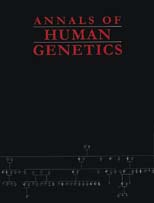Article contents
Allelic association in the FRAX region
Published online by Cambridge University Press: 20 February 2001
Abstract
The sex chromosomes enable direct determination of haplotypes, and the analysis of 8 microsatellite markers from the FRAX region on Xq27-q28 contributes 7219 independent haplotypes from our study in Wessex. Allelic association increases with frequency of alleles, and is less for trinucleotide than dinucleotide repeats. The estimate of ε, the exponential decline of association with distance in kb, is 0.0023. The swept radius 1/ε estimates the distance at which disequilibrium falls to e−1 ≈ .37 of its initial value. The current study estimates the swept radius of association to be 433 kb, which is surprisingly close to estimates for SNPs, and suggests that a marker density of 1/100 kb should be powerful in regions such as FRAX. An explanation for these results is offered, and some speculations made about what will be found when SNPs are subjected to an equally intensive study in multiple regions.
- Type
- Research Article
- Information
- Copyright
- University College London 2000
- 1
- Cited by


